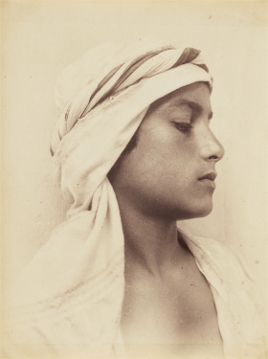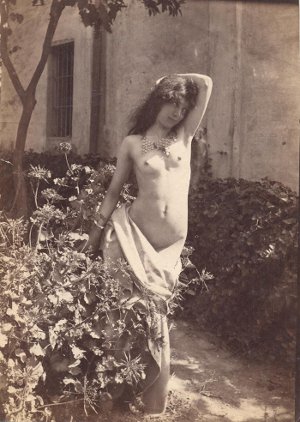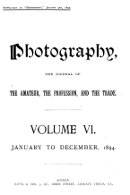Da: The Camera Club conference 1894 / Il convegno pubblico del "Camera Club" 1894 [3/5/1894] [1]
.
(…)
/p. 282/
Yeames
thought the admixture of photography and painting in this way would
fail to take hold of public esteem, and, like the presumptuous man
trying to sit upon two stools, it would eventually come to the
ground.
(…)
|
(…)
/p. 282/
Yeames pensava
che una simile mescolanza di fotografia e pittura non sarebbe riuscita
a conquistare la stima del pubblico e, come l'uomo presuntuoso che
cerchi di sedersi su due sgabelli, alla fine sarebbe caduta a terra.
(…) |
| "I presume that it is
owing to this that these efforts of photography left a painful and
unpleasant feeling on my mind; it was like a man putting on a coat that
was not intended for him, and was consequently a misfit". |
"Presumo che sia per
questo che questi sforzi fotografici mi hanno lasciato una sensazione
dolorosa e spiacevole; era come se un uomo indossasse un cappotto che
non era stato cucito per lui, e di conseguenza gli stesse male".
|
Count Gloeden's nude figure
studies received warm praise, and after a brief reference to "breadth,"
an interesting paper concluded with, "If I have in any way conveyed my
meaning in this paper so as to enlist your concurrence, you will agree
with me that there should never exist any rivalry between painting and
photography, as they each have their own special sphere to work in;
that when one trenches on the other it is to its own detriment, and
that the mission of one is to move us to admiration and love of the
glorious works of Providence through our hearts, and the mission of the
other is to move us to the admiration and study of the works through
our intellect".
|
Gli studi di figura di nudo del conte Gloeden
hanno ricevuto
calorosi elogi e, dopo un breve riferimento all'"ampiezza", un
interessante intervento ha concluso con: "Se isono riuscito in qualche
modo a esprimere ciò che intendo in questo intervento, in modo da
ottenere il vostro consenso, concorderete con me sul fatto che non
dovrebbe
mai esistere rivalità tra pittura e fotografia, poiché ciascuna
ha la propria sfera specifica in cui operare; e che quando l'una si
trincera
contro l'altra lo fa a proprio danno, e che la missione dell'una è
muoverci
all'ammirazione e all'amore delle gloriose opere della Provvidenza
attraverso i nostri cuori, mentre la missione dell'altra è di muoverci
all'ammirazione e allo studio di queste opere attraverso il nostro
intelletto". |
| (…) |
(...) |
| Rev. F. C. Lambert said
that on many points his ideas were quite in accord with the paper. |
Il Rev. F. C. Lambert ha affermato che su
molti punti le sue idee concordavano pienamente con l'intervento.
|
| It
was so specially in one, and although it was with him the same old
topic, and was like flogging a dead horse, he still held the opinion
that it was the greatest possible mistake on the part of photographers
to imitate paintings. Each art should bring its own qualities to bear
upon its own work.
|
E
lo erano specialmente su un punto, e sebbene da lui ciò fosse stato
detto e ridetto, come pestare l'acqua nel mortaio, era ancora
dell'opinione che il più grande errore
possibile da parte di un fotografo fosse imitare i dipinti. Ogni arte dovrebbe apportare le
proprie qualità specifiche, per sostenere il proprio lavoro. |
He confessed surprise at Mr. Yeame's admiration for
Count Gloeden's work. Personally he was very disappointed with them,
the bodies did not look like flesh at all, but like bronze statues.
|
Ha confessato di essere sorpreso
dall'ammirazione del signor Yeame per il lavoro del conte Gloeden.
Personalmente ne era rimasto molto deluso: i corpi non sembravano affatto
carne, ma statue di bronzo. |
| (...) |
(...) |

Wilhelm von Gloeden, Ahmed.
| Mr. Murrell said that
Mr. Yeames evidently had the idea that all Count Gloeden did was to
take the cap off. |
Il signor Murrell ha detto che il signor Yeames evidentemente aveva l'idea che tutto ciò che il conte Gloeden avesse fatto fosse stato togliere il copriobiettivo. |
| He seemed to assume that the Sicilian peasants were
naturally liable to pose in artistic attitudes. . |
Sembrava supporre che i contadini siciliani fossero naturalmente inclini a posare in atteggiamenti artistici.
|
|
But he had been at
Taormina, and his enquiries enabled him to say that these models were
perfectly uneducated, and were in no way appreciative of art. |
Ma lui era stato a Taormina, e le sue indagini gli avevano permesso di dire che
questi modelli erano totalmente ignoranti e non apprezzavano in alcun
modo l'arte. |
|
Their
object was really to obtain an extra bottle of the wine of the country,
and they preferred lazily basking in the sun to harder work to achieve
that end. |
Il loro scopo era in realtà ottenere una bottiglia in più del
vino del paese, e preferivano crogiolarsi pigramente al sole piuttosto
che lavorare più duramente per raggiungere tale scopo. |
|
Indeed, he was willing to say that the photographer had
little help from his models, and nothing but the artistic taste and
careful painstaking work of Count Gloeden could have produced the
results so justly admired. |
In effetti, era disposto a dire che il fotografo aveva ricevuto poco
aiuto dai suoi modelli, e solo il gusto artistico e il lavoro attento e
scrupoloso del conte Gloeden aveva potuto produrre i risultati così
giustamente ammirati.
|
|
Upon the question of models generally, he
thought photography might help painters.
|
Per quanto riguarda i modelli in generale, pensava che la fotografia possa aiutare i pittori.
|
|
The young artist had, as a
rule, only one model at command, with the result probably that she
would be found at an exhibition in one picture as Undine, in others a
fairy or a syren. |
Di
regola il giovane artista aveva a disposizione una sola modella, col
risultato che costei in una mostra sarebbe apparsa in un quadro come
Ondina, e in
altri come una fata o una sirena.
|
|
He hoped photography would succeed in getting rid of
this obtrusive young person. |
Sperava quindi che la fotografia riesca a liberarci da questo tipo di giovane importuno. |

Wilhelm von Gloeden, Nudo femminile.
Mr. Pringle, also referred to Count
Gloeden's work, which had strongly attracted his attention.
|
Anche il signor Pringle ha fatto riferimento all'opera del conte Gloeden, che aveva fortemente richiamato la sua attenzione.
|
He himself
had spent a good deal of time in Italy, but had never seen the
peasantry to possess any specially natural artistic feeling. The
excellence of the pictures was due to the producer, and not to the
models.
|
Aveva trascorso
molto tempo in Italia, ma non aveva mai visto nei contadini un
sentimento artistico particolarmente naturale. L'eccellenza delle
immagini era dovuta all'autore, e non ai modelli.
|
One standing difference between the painter and photographer,
and a fundamental difference, was that of time of execution.
|
Una differenza notevole tra il pittore e il fotografo, ed è una
differenza fondamentale, è quella del tempo d'esecuzione.
|
The
painter was a long time over his picture, whereas the photographer made
perhaps half-a-dozen shots at his models, and then sent the result to
the Salon or some other place. And very often it would be better if
they were all sent to "some other place".
|
Il pittore ha lavorato a lungo sul suo quadro, mentre il fotografo
ha fatto forse una mezza dozzina di scatti ai suoi modelli, e poi ha
inviato il risultato al Salon o da qualche altra parte. E molto spesso
sarebbe meglio se fossero stati mandati tutti “da qualche altra parte”.
|
Mr. Yeames, in reply, doubted
greatly whether photographs had done very much in the education of the
public to the appreciation of pictures.
|
Il signor Yeames, in risposta, dubitava fortemente che le
fotografie avessero contribuito molto all'educazione del pubblico
all'apprezzamento delle immagini.
|
He thought the weakest point
about photography was that it conveyed no expression of the
individuality of the producer, which even a drawing, however rough,
certainly could do.
|
Pensava che il punto debole della fotografia fosse che non
trasmetteva alcuna espressione dell'individualità dell'autore, cosa
che anche un semplice disegno, per quanto approssimativo, può invece fare con certezza. |
-----------------------------------
[Fare
clic qui per l'indice delle pagine su Gloeden e Plueschow]
-------------------------------------
L'autore ringrazia fin
d'ora chi vorrà aiutarlo a trovare immagini e ulteriori dati su
persone, luoghi e fatti descritti in questa pagina, e chi gli segnalerà
eventuali errori in essa contenuti.
|
Note
[1] Da: Anonimo, The Camera Club conference 1894, “Photography”, VI 1894, May 3rd, pp. 281-285. Online su Google books. Traduzione mia.
Questo
è il verbale del convegno tenuto a Londra nei giorni 23 e 24 aprile
1894, interessante per i commenti "a caldo" sul debutto artistico
ufficiale di Gloeden.
Il "Camera Club"
era un circolo d'appassionati di fotografia, vicino alle idee del
"pittorialismo fotografico", che pensava che la fotografia non dovesse
limitarsi al ruolo puramente tecnico e documentaristico di "fotocopia
della realtà", ma potesse aspirare (come la pittura) al ruolo di arte.
I commenti si riferiscono al saggio "Pittura
e fotografia", letto in questa occasione da W. F. Yeames, della Royal Academy.
Si noti anche qui la debolezza umana di Gloeden di spacciarsi per "conte" (che non era).
|




